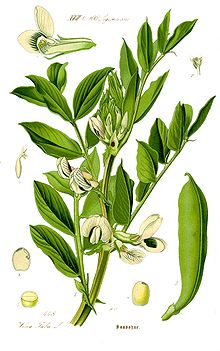Vicia faba
| Vicia faba | |
|---|---|
 |
|
| Vicia faba plants in flower | |
| Scientific classification | |
| Kingdom: | Plantae |
| (unranked): | Angiosperms |
| (unranked): | Eudicots |
| (unranked): | Rosids |
| Order: | Fabales |
| Family: | Fabaceae |
| Subfamily: | Faboideae |
| Tribe: | Vicieae |
| Genus: | Vicia |
| Species: | V. faba |
| Binomial name | |
|
Vicia faba L. |
|
| Synonyms | |
|
Faba sativa Moench. |
|
 |
|
| Nutritional value per 100 g (3.5 oz) | |
|---|---|
| Energy | 1,425 kJ (341 kcal) |
|
58.29 g
|
|
| Dietary fiber | 25 g |
|
1.53 g
|
|
|
26.12 g
|
|
| Vitamins | |
| Thiamine (B1) |
(48%)
0.555 mg |
| Riboflavin (B2) |
(28%)
0.333 mg |
| Niacin (B3) |
(19%)
2.832 mg |
| Vitamin B6 |
(28%)
0.366 mg |
| Folate (B9) |
(106%)
423 μg |
| Vitamin C |
(2%)
1.4 mg |
| Vitamin K |
(9%)
9 μg |
| Minerals | |
| Calcium |
(10%)
103 mg |
| Iron |
(52%)
6.7 mg |
| Magnesium |
(54%)
192 mg |
| Manganese |
(77%)
1.626 mg |
| Phosphorus |
(60%)
421 mg |
| Potassium |
(23%)
1062 mg |
| Sodium |
(1%)
13 mg |
| Zinc |
(33%)
3.14 mg |
|
|
|
|
|
| Percentages are roughly approximated using US recommendations for adults. Source: USDA Nutrient Database |
|
Faba sativa Moench.
Vicia faba, also known as the broad bean, fava bean, faba bean, field bean, bell bean, English bean, horse bean, Windsor bean, pigeon bean and tic(k) bean, is a species of flowering plant in the vetch and pea family Fabaceae. The origin of this legume is obscure, but it had been cultivated in the Middle East for 8,000 years before it spread to Western Europe. Fava beans have been found in the earliest human settlements. They probably originated in the Near East during the Neolithic Age and by the Bronze Age had spread to Northern Italy. They have been found in lakeside settlements in Switzerland and in Britain at Glastonbury. Remains are reported to have been found in Egyptian tombs. In Egypt, the beans were considered commoner food and were shunned by the upper classes. Fava beans were cultivated by the Egyptians, Greeks and Romans. In ancient Rome, they were used in funeral rites. Like all priests of the Orphic and Eleusinian mysteries who were forbidden from ever touching, mentioning, or looking at Fava beans, Pythagoras forbade his followers from doing the same and some claimed that it was due to his belief that fava beans contained the souls of the dead. This once forbidden bean is also related to favism, a genetic deficiency most commonly affecting people of Mediterranean origins. Initiates of the Eleusinian mysteries where studies were done on a ritual that transmogrified participants were said to have a deathlike experience after ingesting the kykeon and would then pass by the home of Kyamites, the Greek demigod of Fava beans.
In parts of the English-speaking world, the name "broad bean" is used for the large-seeded cultivars grown for human food, while "horse bean" and "field bean" refer to cultivars with smaller, harder seeds (more like the wild species) used for animal feed, though their stronger flavour is preferred in some human food recipes, such as falafel. The term "fava bean" (from the Italian fava, meaning "broad bean") is used in other English-speaking countries such as the United States. "Broad bean" is the most common name in the United Kingdom, Australia and New Zealand.
...
Wikipedia
